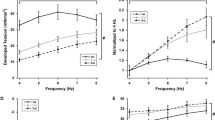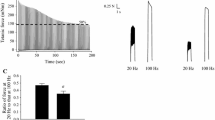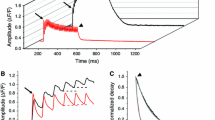Abstract
Force recovery from fatigue in skeletal muscle may be very slow. Gross morphological changes with vacuole formation in muscle cells during the recovery period have been reported and it has been suggested that this is the cause of the delayed force recovery. To study this we have used confocal microscopy of isolated, living muscle fibres from Xenopus and mouse to visualise transverse tubules (t-tubules) and mitochondria and to relate possible fatigue- induced morphological changes in these to force depression. T-tubules were stained with either RH414 or sulforhodamine B and mitochondrial staining was with either rhodamine 123 or DiOC6(3). Fatigue was produced by repeated, short tetanic contractions. Xenopus fibres displayed a marked vacuolation which started to develop about 2min after fatiguing stimulation, reached a maximum after about 30min, and then receded in about 2h. Vacuoles were never seen during fatiguing stimulation. The vacuoles developed from localised swellings of t-tubules and were mostly located in rows of mitochondria. Mitochondrial staining, however, showed no obvious alterations of mitochondrial structure. There was no clear correlation between the presence of vacuoles and force depression; for instance, some fibres showed massive vacuole formation at a time when force had recovered almost fully. Vacuole formation was not reduced by cyclosporin A, which inhibits opening of the non-specific pore in the mitochondrial inner membrane. In mouse fibres there was no vacuole formation or obvious changes in mitochondrial structure after fatigue, but still these fibres showed a marked force depression at low stimulation frequencies (‘low-frequency fatigue’). Vacuoles could be produced in mouse fibres by glycerol treatment and these vacuoles were not associated with any force decline. In conclusion, vacuoles originating from the t-tubular system develop after fatigue in Xenopus but not in mouse fibres. These vacuoles are not the cause of the delayed force recovery after fatigue.
Similar content being viewed by others
References
ALLEN, D. G., LEE, J. A. & WESTERBLAD, H. (1989) Intracellular calcium and tension during fatigue in isolated single muscle fibres from Xenopus laevis. J. Physiol. 415, 433-458.
BRUTON, J. D., LAÈ NNERGREN, J. & WESTERBLAD, H. (1998) Mechanisms underlying the slow recovery of force after fatigue: importance of intracellular calcium. Acta Physiol. Scand. 162, 285-293.
CHIN, E. & ALLEN, D. G. (1996) The role of elevations on intracellular [Ca2+] in the development of low frequency fatigue in mouse single muscle fibres. J. Physiol. 491, 813-824.
DULHUNTY, A. F. & FRANZINI-ARMSTRONG, C. (1975) The relative contribution of the folds and caveolae to the surface membrane of frog skeletal muscle fibres at different sarcomere lengths. J. Physiol. 250, 513-539.
EDWARDS, R. H. T., HILL, D. K., JONES, D. A. & MERTON, P. A. (1977) Fatigue of long duration in human skeletal muscle after exercise. J. Physiol. 272, 769-778.
ENDO, M. (1966) Entry of fluorescence dyes into the sarcotubular system of the frog muscle. J. Physiol. 185, 224-238.
FRANZINI-ARMSTRONG, C. (1970) Studies of the triad. I. Structure of the junction in frog twitch fibres. J. Cell Biol. 47, 488-499.
GONZALEZ-SERRATOS, H. A. V., SOMLYO, A. V., MCCLELLAN, H., SHUMAN, L. M., BORRERO, L. M. & SOMLYO, A. P. (1978) Composition of vacuoles and sarcoplasmic reticulum in fatigued muscle: electron probe analysis. Proc. Natl. Acad. Sci. USA 75, 1329-1333.
HALESTRAP, A. P., CONNERN, C. P., GRIFFITHS, E. J. & KERR, P. M. (1997) Cyclosporin A binding to mitochondrial cyclophilin inhibits the permeability transition pore and protects hearts from ischaemia/ reperfusion injury. Mol. Cell Biochem. 174, 167-172.
JOHNSON, L. V., WALSH, M. L. & CHEN, L. B. (1980) Localization of mitochondria with rhodamine 123. Proc. Natl. Acad. Sci. USA 77, 990-994.
JONES, D. A., HOWELL, S., ROUSSOS, C. & EDWARDS, R. H. (1982) Low-frequency fatigue in isolated skeletal muscles and the effects of methylxanthines. Clin. Sci. 63, 161-167.
KROLENKO, S. A., AMOS, W. B. & LUCY, J. A. (1995) Reversible vacuolation of the transverse tubules of frog skeletal muscle: a confocal fluorescence study. J. Muscle Res. Cell Motil. 16, 401-411.
KROLENKO, S. A., AMOS, W. B., BROWN, S. C., TARUNINA & LUCY, J. A. (1998) Accessibility of t-tubules vacuoles to extracellular dextran and DNA: mechanism and potential application of vacuolation. J. Muscle Res. Cell Motil. 19, 603-611.
LAÈ NNERGREN, J. (1990) Volume changes of isolated Xenopus muscle fibres associated with repeated tetanic contractions. J. Physiol. 420, 003116P.
LAÈ NNERGREN, J. & WESTERBLAD, H. (1989) Maximum tension and force-velocity properties of fatigued, single Xenopus muscle fibres studied by caffeine and high K+. J. Physiol. 409, 473-490.
LAÈ NNERGREN, J. & WESTERBLAD, H. (1991) Force decline due to fatigue and intracellular acidification in isolated fibres from mouse skeletal muscle. J. Physiol. 434, 307-322.
LAÈ NNERGREN, J., WESTERBLAD, H. & FLOCK, B. (1990) Transient appearance of vacuoles in fatigued Xenopus muscle fibres. Acta Physiol. Scand. 140, 437-445.
NAGESSER, A. S., VAN DER LAARSE, W. J. & ELZINGA, G. (1994) Lactate efflux from fatigued fast-twitch muscle fibres of Xenopus laevis under various extracellular conditions. J. Physiol. 481, 139-147.
OGATA, T. & YAMASAKI, Y. (1985) Scanning electron-microscopic studies on the three-dimensional structure of the sarcoplasmic reticulum in the mammalian red, white and intermediate fibres. Cell Tissue Res. 242, 461-467.
RAMBOURG, A. & SEGRETAIN, D. (1980) Three-dimensional electron microscopy of mitochondria and endoplasmic reticulum in the red muscle fiber of the rat diaphragm. Anat. Rec. 197, 33-48.
RATKEVICIUS, A., SKURVYDAS, A. & LEXELL, J. (1995) Submaximal-exercise-induced impairment of human muscle to develop and maintain force at low frequencies of stimulation. Eur. J. Appl. Physiol. 70, 294-300.
SMITH, R. S. & OVALLE, W. K. (1973) Varieties of fast and slow extrafusal muscle fibres in amphibian hind-limb muscles. J. Anat. 116, 1-24.
WESTERBLAD, H., DUTY, S. & ALLEN, D. G. (1993) Intracellular calcium concentration during low-frequency fatigue in isolated single muscle fibers of mouse skeletal muscle. J. Appl. Physiol. 75, 382-388.
WESTERBLAD, H. & LAÈ NNERGREN, J. (1986) Force and membrane potential during and after fatiguing, intermittent tetanic stimulation of single Xenopus muscle fibres. Acta Physiol. Scand. 128, 369-378.
WESTERBLAD, H. & LAÈ NNERGREN, J. (1990) Reversible increase in light scattering during recovery from fatigue in Xenopus muscle fibres. Acta Physiol. Scand. 140, 429-435.
WESTERBLAD, H., LEE, J. A., LAMB, A. G., BOLSOVER, S. R. & ALLEN, D. G. (1990) Spatial gradients of intracellular calcium in skeletal muscle during fatigue. Pflugers Arch. 415, 734-740.
Author information
Authors and Affiliations
Rights and permissions
About this article
Cite this article
Lännergren, J., Bruton, J.D. & Westerblad, H. Vacuole formation in fatigued single muscle fibres from frog and mouse. J Muscle Res Cell Motil 20, 19–32 (1999). https://doi.org/10.1023/A:1005412216794
Issue Date:
DOI: https://doi.org/10.1023/A:1005412216794




